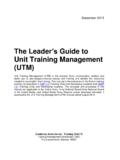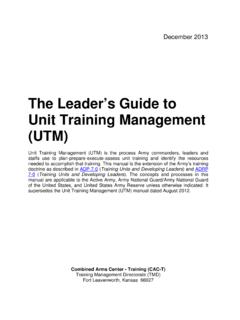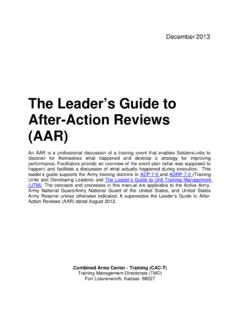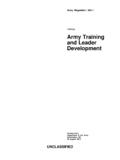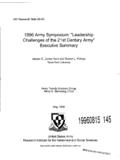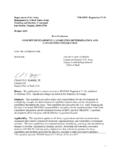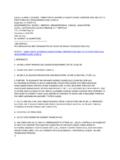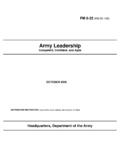Transcription of Army Training Strategy (ATS) - pagebaldwin.com
1 army Training Strategy i PREFACE This version of the army Training Strategy (ATS) replaces the previous version, dated 12 November 2009. This revision incorporates current guidance received from army senior leaders . The ATS has been synchronized with the army Campaign Plan (ACP) since 2007. The ATS incorporates changes already approved as part of ACP 2011. The goals and objectives in the previous ATS have been updated to support the Campaign Objectives, Major Objectives, and subtasks in ACP 2011. This new Strategy has been shaped by the army Policy Synchronization Drill (APSD) the CSA initiated in July 2010 and ensuing ARFORGEN Synchronization Orders (ASO) from HQDA, guidance from the army Training and Leader development Conference in July 2010, the army Leader development Strategy , army Learning Concept for 2015, and the army Training Concept, 2012-2020, as well as other senior leader decisions.
2 The army continues to refine a number of important Training concepts. Final decisions by army senior leaders are still pending on a number of important Training topics, so some details of Training guidance are missing in those areas. As issues are resolved by senior leader decisions, the ATS will be updated to reflect new guidance. These areas include the ACP 2011 metrics, Contingency Expeditionary Force (CEF) Training Strategy , ARFORGEN aim points for Training , functional/multifunctional unit Training strategies, Combat Training Center Full Spectrum Operations (FSO) rotations, operationalizing the reserve component, and regional Training support concepts.
3 army Training Strategy ii CONTENTS Introduction .. 1 Purpose .. 2 Vision .. 2 Environment .. 3 Complementary Efforts .. 3 How the army Will Train Units .. 8 Major Objectives and Tasks .. 9 Discussion of Resources .. 19 Management of Objectives and Tasks .. 19 Appendices .. 20 army Training Strategy 1 Introduction The army is confronting a challenge. We must institutionalize a supply-based ARFORGEN model consisting of Full Spectrum Operations (FSO) capable conventional forces using the 1/5/20/90K Mission Force and 1/3/10/41K Surge Force packaging construct while balancing the requirements of the future army (based on current 1:2 (AC)/1:4 (RC) BOG: Dwell ratio).
4 1 Institutionalizing the supply-based ARFORGEN model is critical to setting conditions for maintaining the long-term health of the force. ARFORGEN is the structured progression of readiness over time to produce trained, ready, and cohesive units prepared for operational deployment in support of Combatant Commanders and other army requirements. Commanders must adapt their Training to remain responsive to current needs while preparing for future demands. Transforming Training and Training management systems is critical to supporting ARFORGEN.
5 The ATS is a key to our success in this endeavor. The ATS remains a strategic document supporting the ACP and the army Training and Leader development Guidance, along with the army Leader development Strategy (see Figure 1). There is a change in the relationship between the ACP and the ATS. Objectives and tasks in ACP 2011 provide guidance for Training army units, Soldiers, Civilians and leaders , with increased involvement by the army Secretariat in the management of ACP objectives. ACP objectives involving Training and leader development are under the oversight of the Assistant Secretary of the army for Manpower and Reserve Affairs, ASA(M&RA), coordinated by the HQDA G-3/5/7.
6 In ACP 2011, Major Objectives for Training and leader development will include measurable tasks and metrics. Tasks in the ATS complement and are synchronized with ACP objectives and tasks, and provide more detailed guidance than is found in the ACP. 1 The Mission Force package produced by the ARFORGEN process in the Available Force Pool is composed of both Active Component and Reserve Component forces and consists of one corps headquarters, five division headquarters, twenty brigade combat teams (BCT), and 90,000 enablers to support these formations (abbreviated as 1/5/20/90K).
7 The Surge Force package is selected units in the Train/Ready Force Pool and consists of one corps headquarters, three division headquarters, ten BCTs, and 41,000 enablers (abbreviated 1/3/10/41K). army Training Strategy 2 army senior leaders have provided guidance on how to meet the challenge of institutionalizing supply-based ARFORGEN. The CSA directed the army Policy Synchronization Drill (APSD) in July 2010. As a result of this effort, the army will adopt specific implementation guidance on the manning, equipping, and Training components of the ARFORGEN Aim Points.
8 Aim Points are Manpower, Equipment and Training targets at specific points in time that enable effective collective Training and ensure forces are ready for contingencies and deployments as units cycle through the ARFORGEN process. Aim Point objectives are currently being reviewed and developed by army Components for Chief of Staff of the army approval. The Training components of this guidance address Combat Training Centers (CTC), Contingency Expeditionary Force (CEF) and home station Training . APSD decisions have been documented in the ARFORGEN Synchronization Order (ASO) FRAGO #1 dated 07 December 2010.
9 The ATS will continue to be shaped by this guidance. Purpose The ATS provides guidance on how the army will maintain its combat edge and prepare units for full spectrum operations. It also provides a balance between the need to succeed in the current war and to build agility to prevail in future conflicts. The specific time frame for this Strategy is the near-term requirements of the execution and budget years (FY 2011-2012) and the longer-term requirements of the Program Objective Memorandum (POM) years FY 2013-2017.
10 The ATS is intended to address the needs of leaders and commanders in all components in army Commands, army Service Component Commands, Direct Reporting Units, the army Staff, and other activities involved in the planning, preparation, and execution of army Training . Vision army Training will be realistic, tough, demanding, fast-paced, and adapted for full spectrum operations against hybrid threats. As units have more time for Training , they will train against a broader range of threats and in a broader range of environments (both materiel and cyberspace).
